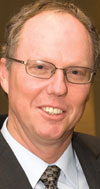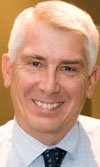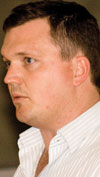

Reporting on the third annual iLegal conference held in Johannesburg last year.
Hi-Tech Security Solutions in association with Dr Craig Donald hosted the third annual iLegal conference covering the effective and legal use of CCTV late last year. iLegal brings together the best local and international experience dealing with the legal operation of CCTV in a variety of environments.
There was far too much information presented to effectively report back on all of it, but below are some of the highlights.

Graeme Gerrard, deputy chief constable at the Cheshire Constabulary in the UK, delivered this year’s keynote. Gerrard is a respected international speaker on CCTV and makes representation to the UK Government as part of his responsibilities. He has also played a leading role in formulating the National Strategy for CCTV on behalf of the UK Government.

Gerrard said the history of CCTV in the UK is a long one that has seen the country being forced to deal with numerous issues along the way. CCTV was first installed in certain shops in the country in 1967 and it was in 1975 that the first 75 cameras were installed in the London underground. The first public CCTV installation occurred in 1985 with the installation of four cameras in Bournemouth and in 1994 a central government fund for CCTV in town centres was established. By 1996 there were 5000 CCTV cameras in the London underground, with approximately 4,2 million installed in the UK in 2004.
The number is contentious and is a best guess Gerrard explains, including private cameras in offices that are not controlled by the safety and security services.
The UK opted for the CCTV route earlier than most countries due to the significant increase in crime and terrorism in the 1970s and 1980s. One of the first issues to deal with was that the country had no human rights legislation on the books at that time, and hence no privacy laws. This was obviously a concern as the safety and security services could do anything they chose to as long as it was not overtly illegal.
Over the years, the situation has changed and the actions these services can take are now carefully defined by law. More importantly, they can provide good insight to other countries that are still in the process of fleshing out their privacy and related CCTV laws. In fact, with government support, the CCTV rollout in the UK has the support of 86% of the public – despite some loud protesting voices.
One of the warnings Gerrard offered the iLegal attendees was the dangers of a lack of experience in local government. At one stage, the UK government spent 170 million pounds over three years, money that was given to local councils to manage their own CCTV systems. Because of the lack of experience of many of the people tasked with this job, vendors took advantage of them and many sites had inappropriate systems installed. This should obviously be a major concern in South Africa where checks and balances do not exist.
Gerrard also points out that CCTV has many uses that make it more than simply a crime-fighting tool. Some of these include:
* Patrolling city areas via camera to make optimal use of resources.
* Intelligence gathering.
* Traffic management.
* Incident and evacuation management.
In summing up, some of Gerrard’s lessons learned include:
* Set standards early on to prevent vendors from taking advantage.
* Standardise equipment and processes.
* There must be regulations in place to monitor standards.
* There must also be a performance measurement plan.
* Deal with capacity issues upfront – the capacity to monitor all your cameras effectively, for example.
* Dealing with images must also be planned in advance. In other words, what resolution will you record at and how will the images be handled to ensure they are admissible in court and the perpetrators identifiable.
Gerrard provided much more during his keynote than we can include in this article, however, he ended by suggesting that while CCTV can deliver excellent results, it is not always the answer. Before embarking on a surveillance project, he advised understanding what you want, why you want it and what you want to achieve. With that knowledge, a better decision as to the value of CCTV can be made.
An integrated solution
Following Gerrard, Gary Cowper-Johnson, MD of Afrisec Group presented a case study on a successful surveillance solution.

In 2005, the Nelson Mandela Bay Municipality acknowledged issues with its security systems and, in preparation for the 2010 Soccer World Cup; it began working on a proposal to FIFA in terms of an holistic security master plan.
Up to that point, the security system in Nelson Mandela Bay Municipality had the appearance of a patchwork quilt, with the approach being very fragmented. The whole system was characterised by a false sense of security that in reality was an uncoordinated approach that resulted in fruitless expenditure. The area was faced with a number of installed systems that were unable to communicate with each other. In the absence of a central control facility, these freestanding security systems had little use. What was needed was an integrated security system capable of tying all the area’s CCTV cameras into a centralised control and monitoring facility. Known as the Integrated Facilities Management System, the Security Master Plan is the catalyst for a change in mindset and the utilisation of technology to assist security officers in the performance of their function.
The area needed a joint operational and judicial (SAPS) structure so it drafted the relevant policies to maximise cooperation and the sharing of information among departments. This involved integrating the police with metro staff and disaster management teams.
One of the first steps in the process was the identification of the target areas to be observed with the CCTV camera system, since the primary missions were to prevent crime; provide assistance with traffic control; implement a disaster management programme; institute crowd control; and assist with fire and rescue.
“We placed 562 cameras at strategic points, all running on the fibre-optic communications backbone, using a Tetra network. Some cameras were placed in buildings; some were early warning systems; over 200 cameras were located in the stadium and at the training stadia; and the remainder were used as mobile surveillance cameras. All the information from these cameras was fed into a central database which was crucial to the success of the system,” Cowper-Johnson said.
“We decided to use an independent IP-based network to ensure the integrity of all data collected. This meant that we needed to utilise a separate security network, using our own radio channel and backbone.”
In addition to the presence of mobile cameras, it was decided to implement a number of mobile control rooms. This means the municipality was able to position teams where major crimes were happening. The data was linked onto the network and provided real-time information from self-sustained units. The Nelson Mandela Bay Municipality wanted all data from all the cameras to be fed into all of the control rooms.
“We decided in the early stages that the best way to provide finite control of the operation was to have a Joint Operations Centre (JOC). This was a brilliant solution as all the major players were in one place 24/7, making joint decisions regarding security and disaster management.
“We monitored the success of the system through security reports compiled from occurrence books whereby the raw data was managed through software for a performance audit as part of the overall plan. We also performed offsite maintenance monitoring facility on the health of network since we needed to provide the Nelson Mandela Bay Municipality with 95% availability,” Cowper-Johnson added.
Best impact of surveillance
Colin Brown, global head of security at De Beers followed with some thoughts on how to attain the greatest impact from surveillance. He noted a number of challenges for security teams that make it more difficult to do their jobs today. Many of these deal with the lack of drive among security personnel. Additionally, Brown noted, “Good criminals are hard to detect, and if you do not detect then maybe there is no problem ... and this can become the norm: throughout the value chain.”
The reality is also that security delivers no revenue, it is a cost and budgets tend to trend downwards until there is a major incident. The cost to value ratio is not always clear or well articulated.
A key point he made was that too often “security folk are not as motivated, bold or as driven as best criminals. People need to be motivated by training and measurement; rewarded for doing well, punished for doing badly. Training also helps us think like criminals and identify where the vulnerabilities are.”
He spent some time talking about the human factor to security and how important it is to motivate and train people efficiently and to implement an integrated security solution, of which surveillance is a part. In business, the security leader also needs to identify the value returned to business by the security operations as well as the intangible benefits.
Following Brown, Sharleen Haggard, second prosecutor for the National Prosecution Service in Pietermaritzburg gave us a view into what a prosecutor’s job is and how surveillance should be used effectively by businesses.

The view from the prosecutor’s bench
The ideal for the prosecutor is to see justice done. The prosecutor needs to illustrate to the magistrate that he/she has proved the case beyond reasonable doubt. This prosecution follows on a long investigation by the police and other role players. In Pietermaritzburg, this means the involvement from the SAPS and the Safe City initiative. In addition, Legal Aid (the defence) and the witnesses also play a role in presenting CCTV cases.
Haggard said that the equipping of a courtroom dedicated to the hearing of CCTV footage cases has been a boon for the National Prosecution Service. “In many cases we are able to circumvent the whole legal process by having the defence and the defendant view the material upfront and acquire a guilty plea without further representation being necessary.
“We needed to ensure that footage was permissible in terms of quality so we managed to achieve this through the training of Safe City’s CCTV operators on the correct manner of zooming in on suspects to acquire a clear image,” said Haggard.
The prosecuting office also circumvented the defence’s argument that there was no way of claiming that the person arrested was the same person perpetrating the crime. By firstly, not losing sight of the accused, then by taking the accused back to the relevant camera to take a clear snapshot of him when he had been apprehended, they were able to provide a positive identification.
Haggard said that in the prosecution’s opinion, the most important factor is that the magistrate needs to be able to experience what has happened in an offence, almost as if he/she was present. “This lends a sense of reality to the case and, especially in the case of violent crime, allows sentencing to be passed down accordingly. Because the footage pinpoints a crime without a shadow of a doubt, it removes the danger of bias and misinterpretation.”
From the perspective of the accused, by seeing themselves on film, wearing their own clothes and displaying their own identifying marks (tattoos, scars etc), there is an increased chance that he/she will plead guilty, thus reducing the burden on the legal system and effectively ridding society of a criminal liability.
“Since the implementation of Safe City and our dedicated courtroom, we have been able to secure 98% of the cases as convictions. The remaining 2% are unsuccessful only because we have been unable to obtain witnesses in the matter. This alone is testimony to the success of the project,” said Haggard.
Understanding thermals
Camsecure’s Francois Malan followed with a more technical demonstration of the effectiveness of thermal cameras in spotting suspects 24-hours per day by measuring the infrared radiation objects emit. All objects, including people emit this radiation and the latest range of thermal cameras make it easy to spot people moving about, even while hidden from the naked eye.

While being a strictly military technology for some time, thermal cameras today offer amazing images to commercial security operations as well. The cameras can be costly, but Malan points out that they actually save money when compared to what traditional solution would be required to achieve the same results.
He did note, however, that thermal cameras are not cameras in the usual sense that they can identify a person, they are unbeatable in identifying objects and movement, but users will not be able to submit the footage in court to identify criminals. The benefit is they operate effectively in total dark or in the midday sun and Malan expects to see intelligent applications being developed around thermal imaging in the near future.
Sgt Lebo Maimane, a SAPS forensic image analyst followed Malan with real-world advice to users regarding how to obtain surveillance images that SAPS can use and that will stand up in court.

Inside CCTV forensics
“As image analysts we are confronted with many challenges. We often find ourselves frustrated and this is in part due to the lack of communication, firstly between companies and the Forensics Analysis Unit as well as between ourselves and the investigating officers,” Maimane said. “We must ask ourselves the question: ‘Who must take accountability for the CCTV equipment – the manufacturers, the installers or the consumers?’ Image analysts often take the blame and take accountability when in fact the fault lies with poor quality footage.”
Public space use of surveillance in our country has increased and CCTV footage has become one of the main sources of information during the forensic investigation of crimes. However, all too often these systems are also affected by poor quality mainly because of practical problems.
“Business owners complain about the cost of CCTV systems and cite this as a reason for not having adequate recording devices,” she said. “Amazingly, there is still a banking institution that makes use of analogue technology. This is obviously not an ideal situation as we have determined that in terms of quality, digital technology wins hands down.”
Maimane said that consumers need to ask themselves the question: “As a consumer what do I want to achieve with CCTV? Is it to be used for monitoring, detection, identification or recognition?”
In line with this question is the fact that camera placement is most often the major problem. Installers often have not established what is the correct placement and positioning of the camera for facial identification. For this reason, correct installation and checking of the system is crucial.
As a pointer, cameras mounted on the ceiling do not provide good facial identification. In addition, recording quality is a big factor in correct facial recognition and identity. It is important to remember that the original copy is always the best one, with each subsequent copy increasingly losing quality and resolution.
Maimane said that companies need to determine in advance where their problem areas are and install the cameras in these zones. Some recommendations she offered include:
* Cameras should be placed with an eye towards facial identification.
* Research your supplier.
* Do not advertise where you will install your cameras.
* Insist on training from the supplier for all users of the equipment.
* Test your system.
Common problems at the Forensics Laboratory:
* Lighting: natural/artificial light can influence image quality.
* Shadows on face due to wearing of hats/caps.
* Lighting and angle of a camera can help or hinder image quality.
* Consider the architecture of building when placing cameras.
* Zooming in on an image does not necessarily make it clearer.
* Registration numbers that are not readable.
* Distance of the camera from the subject matter.
“Another pointer for companies is that you must effectively manage your system. This includes maintenance of the system to ensure it is operating correctly as well as ensuring that the date and time stamp is correct, otherwise this may prejudice the results in court,” cautioned Maimane.
Maimane suggested that companies think outside the box. “If facial identification is not possible, evaluate footage for other evidence, such as scars, jewellery, tattoos and clothing. We are under a legal and moral obligation to avoid manipulation of footage while trying to enhance the recording for identification reasons. We therefore rely on the quality of the footage being suitable and that the investigating officer is competent in the retrieval of the footage.
“We provide full training for investigating officers in this job function to ensure that retrieval procedures are followed in the correct manner. CCTV definitely has a role to play in the reduction of crime, so let us ensure that the evidence provided is ideal from the outset,” Maimane concluded.
The legalities of transmitting CCTV
Gerhard Loots, director of ATEC was up next with a presentation that was both enlightening as well as unexpected. Loots presented an informed view on the legalities governing the transmission of CCTV video in and between business premises.

Due to the monopolistic regulations that governed South Africa’s telecommunications industry for so many years, there was a time when it would have been illegal to transmit CCTV images from a business’s office to another office across the road. Ridiculous, but something we have had to live with for many years. Loots was able to assist those of us who thought these regulations were still in force by explaining the new laws and the new opportunities they provide to companies transmitting video. The laws are far more civilised today.
Loots went into how and why these regulations have changed. He also offered five principles governing when companies can transmit CCTV without having to apply for a licence, concluding by providing a real life scenario based on work done at the Tygervalley Waterfront.
The five principles he suggested are:
1. The network should be used for the owner’s purpose.
2. Do not resell spare capacity on the network.
3. The network should remain incidental to the service provided.
4. A closed group of users should be maintained – ie, password controlled or physically controlled access (monitoring room behind access controlled door).
5. Make sure that the network is operating within other legislation on an access layer – ie, operate within the correct spectrum.
Staying on the legal side, Rob Anderson, MD of Rob Anderson & Associates then discussed the often forgotten and neglected maintenance contract. As Maimane noted, if you do not keep your surveillance systems in good shape you may as well not have them.
The three pillars of a maintenance contract
Anderson maintains that maintenance is a very important element of the management of a company’s CCTV security system. “The security process diagram includes: manpower, electronics/mechanical component; the management of the process; maintenance of the process; and an audit system.
“The system maintenance person is the high-risk component because he is actually the most important person in the security system. This can be claimed because he interacts with everyone in the system and he needs to understand how the technology, for instance an IP network, works. He is at the core of everything but he tends to be treated quite badly,” said Anderson.
Maintenance retains and/or improves the condition of your system so that it is available when you need it with the lowest risk to all parties. The three pillars of a maintenance contract are legal, commercial and technical.
The legal pillar involves:
* Compliance with the Occupational Health and Safety (OHS) Act.
* Security Industry Regulatory Authority (SIRA).
* Tax legislation.
* Workmen’s Compensation.
* Wiring Code (SABS 10142-Part 1).
* Industry-specific regulations.
The commercial pillar includes:
* Insurances against damage to property and person (public liability).
* Payment conditions (when monies are payable).
* Cost increases, which are difficult to control.
* Tax and SIRA clearances that, if not in place, could cost the company money.
* Equipment warranty protection, which is where the biggest loophole occurs. If equipment fails during maintenance period, is this covered? You need to tie it in to the maintenance contract.
* Confidential relationship. The maintenance person carries sensitive information so you need to get him to sign a confidentiality agreement.
Under the technical pillar you will find:
* Planned maintenance schedule – detailing who will be attending to the proactive maintenance, what it entails and when it will happen.
* Monthly report so you can do comparisons of one month to another for auditing purposes.
* Percentage uptime and availability.
* Performance testing – checking whether all cameras are working, which can be established in a planned maintenance schedule.
* Evidence recovery. Often the maintenance person ends up doing this as some of the operators are technically unable to do so, possibly due to lack of training.
* First level of audit – he will make sure the cameras are working.
* Training and retraining of people – possibly sourced through the maintenance person.
* The maintenance person can apply warranty claims.
“You cannot just have a harsh contractual relationship with the maintenance person; you need to create a partnership with him. The maintenance contract protects your investment and should add value, so you need to ensure that you have an unquestionable one in place,” Anderson concluded.
Obtaining value from CCTV
Wrapping up the day’s proceedings was Dr Craig Donald, providing insight into getting the best from your CCTV operators. With the aid of a few video clips, Donald showed how we as humans tend to take our worldview with us when we observe CCTV footage and make assumptions that can often be incorrect.
He said we often see what we expect to see instead of the bare facts and are susceptible and open to suggestion. CCTV operators must be trained to leave their preconceived ideas behind and concentrate on what they are actually seeing, determining what they can establish from the situation. “There is something of worth in every CCTV picture, no matter how minor,” Donald stated. “Small things lead to bigger trends and discoveries.”
Sometimes the operator will not see a crime, but must be able to read the behaviour of people and situations to determine that something is wrong. Importantly, these behaviours need to be demonstrable in court when testifying why someone was apprehended, for example. Gut feel may be right, but it will not get a conviction.
Donald also noted that evidence is cumulative, there is not always a clear image of a crime to close the case. This makes it all the more important that CCTV operators are not simply security guards placed behind a screen, they need to have the aptitude and training to deliver real value.
Contacts
Gary Cowper-Johnson: [email protected]
Francois Malan: [email protected]
Gerhard Loots: [email protected]
Rob Anderson: [email protected]
Craig Donald: [email protected]
| Tel: | +27 11 543 5800 |
| Email: | [email protected] |
| www: | www.technews.co.za |
| Articles: | More information and articles about Technews Publishing (SA Instrumentation & Control) |

© Technews Publishing (Pty) Ltd. | All Rights Reserved.